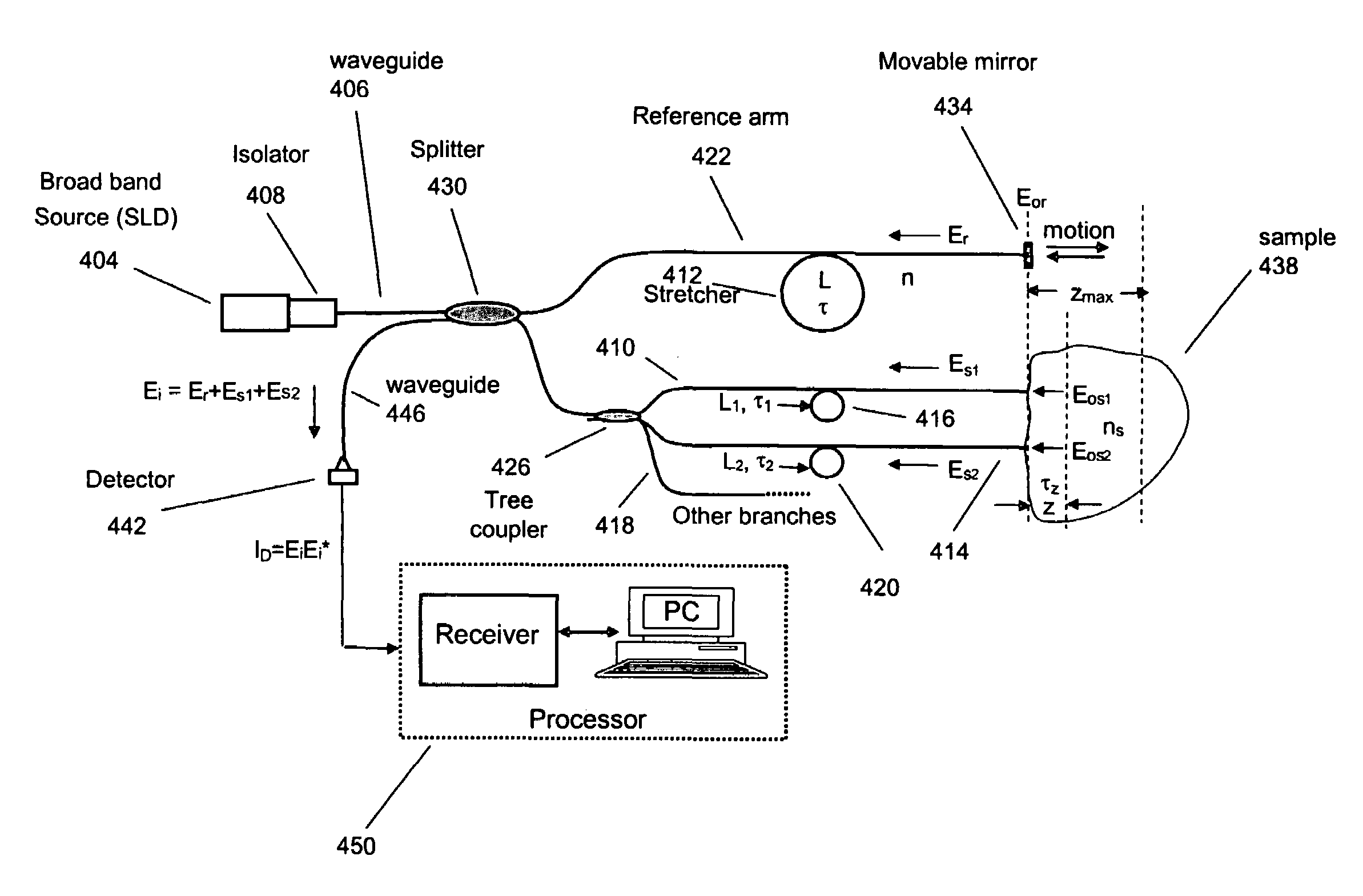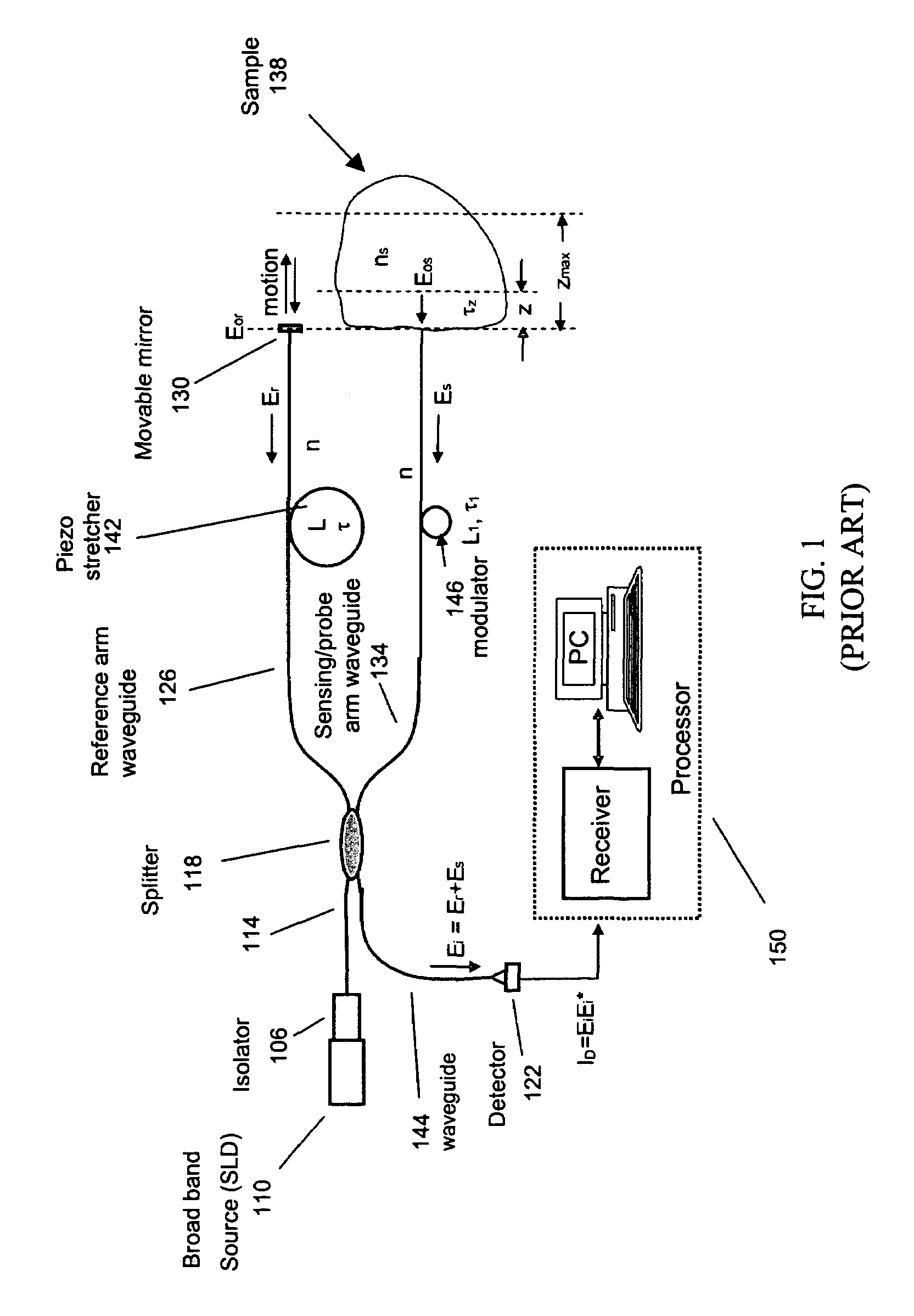Single trace multi-channel low coherence interferometric sensor
a single-channel, low-coherence technology, applied in the field of medicine and engineering, can solve the problems of insufficient biomedical diagnostics, inability to perform conventional excisional biopsy, invasive and time-consuming and costly, etc., to achieve rapid identification of radial positions, reduce data collection and interpretation time, and low coherence
- Summary
- Abstract
- Description
- Claims
- Application Information
AI Technical Summary
Benefits of technology
Problems solved by technology
Method used
Image
Examples
example 1
[0135]This prophetic example illustrates how an version of the present invention can be used for detecting plaque within the coronary or other patient vasculature. The apparatus and techniques could also be applied to characterizing lesions in other body lumens which are associated with various disease conditions. The methods and apparatus can be implemented within the body lumen to identify diseased tissue or monitor the course of treatment for a particular condition. The apparatus is able to interrogate the body lumen over a relatively long distance to characterize the tissue in an efficient fashion by providing interferometric information on the tissue from multiple probes in a single sweep of a variable delay of the apparatus.
[0136]Coronary artery disease resulting from the build-up of atherosclerotic plaque in the coronary arteries is a leading cause of death. The build-up of plaque causes a narrowing of the, artery, commonly referred to as a lesion, which reduces blood flow to...
example 2
[0142]This prophetic example illustrate how a sensor of the present invention may be used in photodynamic therapy to treat and monitor a lesion.
[0143]Photodynamic therapy (PDT) is effective in destroying diseased tissue and tumors using light that is absorbed by a photoreactive agent administered to the patient. The photoreactive agent is selectively preferentially absorbed by or linked to the abnormal or diseased tissue and has a characteristic absorption wavelength or absorption band that activates the agent. When activated by the light, the photoreactive agent can produce compounds that destroy the abnormal tissue. The depth of light penetration, and consequently of the tissue necrosis, is a function of light wavelength, and is typically less than one centimeter.
[0144]PDT may be administered locally to a site in or on a patient using light from an external light source such as a laser that is coupled to a plurality of optical fibers or waveguides. The waveguides that propagate th...
example 3
[0149]This example illustrates a method for characterizing a material sample that includes contacting the material with a sensor having two or more probes or sample arms and a delay compensator or a reference section respectively. Each probe arm can include an adjustable delay, the probe arms and reference section configured such that an interference between backscattered source light from the sample for two or more probe arms and reference light occurs and is detected during a single trace of the delay compensator or reference section.
[0150]Preferably the interference signal for the two or more probe or sample arms are at least partially separated from each other. The material can be a tissue where characterization includes the detection of a disease state of the tissue. Preferably the disease state being characterized is a vulnerable plaque.
PUM
 Login to View More
Login to View More Abstract
Description
Claims
Application Information
 Login to View More
Login to View More - R&D
- Intellectual Property
- Life Sciences
- Materials
- Tech Scout
- Unparalleled Data Quality
- Higher Quality Content
- 60% Fewer Hallucinations
Browse by: Latest US Patents, China's latest patents, Technical Efficacy Thesaurus, Application Domain, Technology Topic, Popular Technical Reports.
© 2025 PatSnap. All rights reserved.Legal|Privacy policy|Modern Slavery Act Transparency Statement|Sitemap|About US| Contact US: help@patsnap.com



